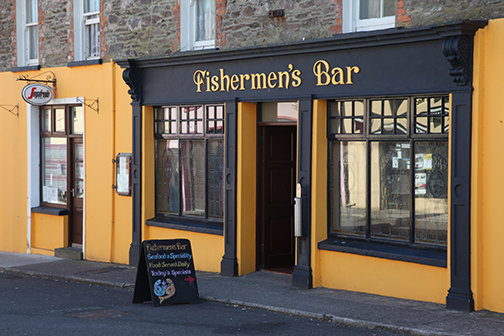Text and pictures by Rudy van Duijnhoven
(Originally published in Tail 30 – July 2017)
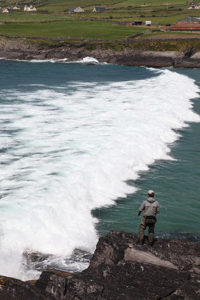 Though mullet are present in large numbers along the coastline of the British Isles and the mainland of Europe, they are not often caught on fly. Mullet can reach weights of well over ten pounds, and the largest of the species swim about in the estuary waters in small groups. You will come across the smaller mullet in larger schools, often feeding hard on the surface. Fly fishers in Denmark are quite successful using seaweed imitations when fishing for these ‘European bonefish’. Others use imitations of bread crust or floating feathers, with which they seem to sometimes have good success. John Quinlan from Ireland developed a method whereby he fishes with imitations of larvae that live in dying, decomposing seaweed. We saw firsthand that these flies can produce good numbers of fish on a recent trip to the Ring of Kerry.
Though mullet are present in large numbers along the coastline of the British Isles and the mainland of Europe, they are not often caught on fly. Mullet can reach weights of well over ten pounds, and the largest of the species swim about in the estuary waters in small groups. You will come across the smaller mullet in larger schools, often feeding hard on the surface. Fly fishers in Denmark are quite successful using seaweed imitations when fishing for these ‘European bonefish’. Others use imitations of bread crust or floating feathers, with which they seem to sometimes have good success. John Quinlan from Ireland developed a method whereby he fishes with imitations of larvae that live in dying, decomposing seaweed. We saw firsthand that these flies can produce good numbers of fish on a recent trip to the Ring of Kerry.
Intercepting larvae
A group of mullet draws closer, a few nice fish among them. They intercept the dead, floating larvae being pushed in their direction by the wind. With their mouths halfway out of the water, they inhale the tasty morsels like trout. Reginald moves close, staying low all the time so as not to spook the fish. He places his fly close to a small group of mullet. Because the fly hangs below the water surface, a strike indicator is placed about a foot from the fly. When the fly is not visible due to ripples on the water or light coming from the wrong side, one can still see the strike indicator. Several of the mullet at first seem to have more interest in the indicator than the fly, but suddenly the indicator dives under; a sign that a mullet has grabbed the fly. Reginald sets the hook and his fly rod doubles over. The mullet swirls in the surface, even makes a few aerial turns before deciding to make a run for it. Reginald fights the fish carefully and skillfully, ensuring he doesn’t put too much pressure on the 3X tippet.
Rising water
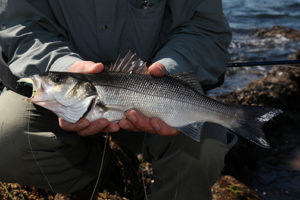 It takes some steering and patience to guide the mullet through the stones and seaweed, but after a few minutes Reginald is able to land the mullet, his first on the fly. A nice fish, some four pounds in weight, with the fly tucked perfectly in the corner of the mouth. The fight and catch provides me with some nice pictures under the cloudless Irish sky. After a few good shots, I pack the camera away, as it’s my turn to try. Because of the rising tide, there is a constant supply of food for the mullet and it does not take too long before another school of feeding mullet moves within casting distance. I place the cast carefully, making sure no shadow goes over the fish. The leader stretches out and a few mullet move in closer. I try to keep my nerves calm, as my strike indicator vanishes out of sight.
It takes some steering and patience to guide the mullet through the stones and seaweed, but after a few minutes Reginald is able to land the mullet, his first on the fly. A nice fish, some four pounds in weight, with the fly tucked perfectly in the corner of the mouth. The fight and catch provides me with some nice pictures under the cloudless Irish sky. After a few good shots, I pack the camera away, as it’s my turn to try. Because of the rising tide, there is a constant supply of food for the mullet and it does not take too long before another school of feeding mullet moves within casting distance. I place the cast carefully, making sure no shadow goes over the fish. The leader stretches out and a few mullet move in closer. I try to keep my nerves calm, as my strike indicator vanishes out of sight.
As it turns out, John Quinlan’s method works quite well. Every day at the right tide, we manage to hook and land a number of mullet. Some fish are lost when the hook pulls out or because the tippet can’t take the strain or is damaged on the sharp, shell-ridden stones. Mullet survive primarily on sand fleas and the larvae of seaweed flies (Coelopa spec.) and the last ones are important to us fly fishers. The larvae closely resemble small maggots; when they end up in the water, they take in air and float on the water just like real maggots.
Equipment
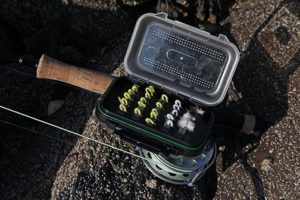 The fly rods we use are 9 or 10-feet long and built for 7-weight lines (for this type of fishing we use floating lines). The leader is about the same length as the fly rod, at times a bit longer, with a loop on the end. The foam strike indicators John uses are quite large with a loop on either side. The strike indicator is looped to the loop at the end of the leader, on the other side is a piece of 3X nylon or fluorocarbon to which the fly is knotted. The fly consists of a strip of white or yellow artificial foam about three millimetres thick, the foam tied in a curved form on to a size 14 or 16 dry fly hook. Before this fly is cast to the mullet, the air is squeezed from it under water in an effort to make it float in the water surface. When the conditions are right, we can see the fly itself, if not we at least have the strike indicator to keep an eye on. After placing the fly close to the school of mullet, we let the wind or current transport the fly. Only when there are no mullet between the fly and the angler can the line be picked up for a new cast.
The fly rods we use are 9 or 10-feet long and built for 7-weight lines (for this type of fishing we use floating lines). The leader is about the same length as the fly rod, at times a bit longer, with a loop on the end. The foam strike indicators John uses are quite large with a loop on either side. The strike indicator is looped to the loop at the end of the leader, on the other side is a piece of 3X nylon or fluorocarbon to which the fly is knotted. The fly consists of a strip of white or yellow artificial foam about three millimetres thick, the foam tied in a curved form on to a size 14 or 16 dry fly hook. Before this fly is cast to the mullet, the air is squeezed from it under water in an effort to make it float in the water surface. When the conditions are right, we can see the fly itself, if not we at least have the strike indicator to keep an eye on. After placing the fly close to the school of mullet, we let the wind or current transport the fly. Only when there are no mullet between the fly and the angler can the line be picked up for a new cast.
So much to offer
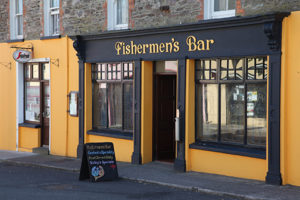 The beautiful landscape of the Ring of Kerry has a lot to offer to the visiting fly fisher. Because of the shape of the Ballinskelligs Bay, the bay in front of Waterville in which the river Inny runs, it is possible to fish here under nearly all circumstances. The positive influence of the warm gulf stream allows anglers to fish here for seabass almost year round. Seabass are the ‘bread and butter’ for saltwater fly fishers. Lough Currane has an international reputation for its large seatrout, and this water is also connected with the same bay by way of a small stream. Lakes higher up that belong to the same system offer excellent fishing for brown trout. The steep rocky shore along some area of the coast offers good chances for pollack. There are also huge sharks that can sometimes be seen here feeding on plankton, but they are a bit too big for your fly rod. The many other species of fish to target will keep you busy anyways.
The beautiful landscape of the Ring of Kerry has a lot to offer to the visiting fly fisher. Because of the shape of the Ballinskelligs Bay, the bay in front of Waterville in which the river Inny runs, it is possible to fish here under nearly all circumstances. The positive influence of the warm gulf stream allows anglers to fish here for seabass almost year round. Seabass are the ‘bread and butter’ for saltwater fly fishers. Lough Currane has an international reputation for its large seatrout, and this water is also connected with the same bay by way of a small stream. Lakes higher up that belong to the same system offer excellent fishing for brown trout. The steep rocky shore along some area of the coast offers good chances for pollack. There are also huge sharks that can sometimes be seen here feeding on plankton, but they are a bit too big for your fly rod. The many other species of fish to target will keep you busy anyways.

